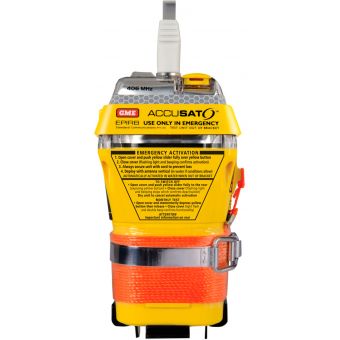Epirbs or
emergency
position-indicating radio beacon is a part of the vessel’s gmdss. This device is outside the bridge and transmits homing signals when the ship sinks. Epirb is an electronic object. Since this is placed outside, it is fixed in an enclosure to protect it from sun, rain, snow, seawater, etc. Epirb hru is simpler than that of the liferaft. The front of its cover is removable. That is how you replace or inspect the epirb or its hydrostatic unit.
 A plastic rod or bolt from the hru locks that same cover using a small pin. When a ship sinks, the hru triggers cutting off the plastic rod.
A plastic rod or bolt from the hru locks that same cover using a small pin. When a ship sinks, the hru triggers cutting off the plastic rod.
This list is provided as a courtesy, showing emergency position indicating radio beacon (epirb) distress beacon models that, if purchased in australia, are known to meet australian standards as/nzs 4280. 1. We recommend epirbs are purchased in australia to ensure compliance with the national system carriage requirements and registration with amsa. These standards are maintained by standards australia. To find out more about any beacon model, see the manufacturer's website. To find out about float-free epirbs, see our float-free epirb page. There may be additional beacons that meet standards that do not yet appear on this page. Amsa does not endorse any particular brand or model of distress beacon.
This standard specifies the minimum performance requirements, technical characteristics and type-testing requirements of 406 mhz emergency position indicating radio beacons (epirbs) used in the cospas-sarsat satellite system, it is based upon iec 61097-2, edition 3. 0 and details only additions, exceptions and changes to that standard.
Emergency position indicating radio beacons for maritime rescues an emergency position indicating radio beacon, or epirb, is a great piece of electronic safety equipment to have aboard your vessel. Once activated either manually or with water, an epirb will send a 406hz radio frequency signal that will alert uscg of your position and enact a quick emergency rescue response.
Search-and-rescue response [ edit ]
Orbiting high overhead every minute of the day is a worldwide network of polar-orbiting and geostationary satellites. Together with russia’s cospas spacecraft, they make up the high-tech international search and rescue satellite-aided tracking system known as cospas-sarsat. Cospas-sarsat has been credited with nearly 30,000 rescues worldwide. The system relies on signals received on the 406 mhz frequency to pinpoint position and speed rescuers to the scene of an emergency on land or at sea. In fact, the more reliable, digital 406 mhz frequency has become the de facto internationally recognized distress frequency. Using the 406 mhz frequency, modern signaling devices can quickly beam gps lat/lon coordinates to orbiting satellites.

Personal Locator Beacon [ edit ]
As the name suggests, a personal locator beacon is designed for use by a person - whereas an epirb is assigned to a vessel. Typically, a plb is attached to a safety device such as a life jacket - or carried in a pocket. Manually activated, the personal locator beacon sends the same signal to the same destination, using the same route, as an epirb. Because plbs can be carried by an individual rather than a vessel, they can be used anywhere in the world - whether on land or at sea. It's a mandatory requirement for all commercial vessels to have an epirb registered onboard, and they should be mounted where they can be quickly grabbed.
The mcmurdo smartfind epirb is the only epirb that can send all three signals- a 406 mhz gps signal, 121. 5 mhz homing signal, and ais signal over vhf radio frequencies. It weighs 2. 68 pounds and requires six lithium-ion batteries. The ais signal sends alerts to commercial ships equipped with ais technology. Ais distress is integrated with most marine radios and also personal locator beacons. It also alerts local vessels that could come to the rescue. This epirb meets all us and international standards. It has a 48-hour fully operational battery with a 10-year storage life span. It also offers protection against accidental activation.
See also [ edit ]
This site and its contents are copyright © 2023 sail-world sail-world australia and/or the original author, photographer etc. All rights reserved. Photographs are copyright by law. If you wish to use or buy a photograph contact the photographer directly. If you have any questions about advertising or editorial then please contact our team. If you encounter any technical issues then please email techsupport@sail-world. Com.
Automatic hydrostatic release unit [ edit ]
Automatically activated epirb must be used on solas vessels, for example passenger cruise liner, container ship or oil tanker. They are supplied with a plastic enclosure in which the sea switch of the epirb is deactivated. The plastic enclosure contains a spring-loaded lever which automatically pushes the enclosure lid off and releases the epirb if the vessel sinks. This automatic ejection is controlled by a device called a hru (hydrostatic release unit) that will automatically release the epirb once a depth of approximately 4-5 m is reached. At which time it will float free to the surface that enables it to be activated by the sea switch.
In an emergency situation the automatically activation of the epirb will dramatically facilitate the rescue operation and the possibility to save lives. The hammar h20 is the most reliable hydrostatic release unit on the market and is used by most leading epirb manufactures. The hammar h20 is widely used for emergency position indicating radio beacons (epirb). 50% of the world’s epirb manufacturers are using the hammar h20 for the free-float function. Should the vessel sink, the hammar h20, which is activated by increasing water pressure, automatically release the epirb. On reaching the surface the epirb starts to emit a signal of identification and position to a satellite.
No comments:
Post a Comment